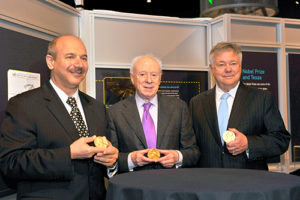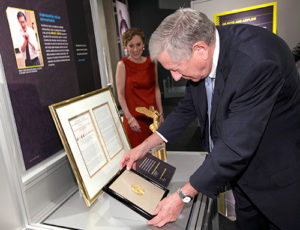A CLOSER LOOK AT THE HOME OF SIX NOBEL LAUREATES
The University of Texas Southwestern (UT Southwestern) Medical Center has become the only academic medical center in the world to serve as home to six Nobel Laureates for one reason: Science is literally woven into the institution’s DNA.

“I wanted to develop a genetics program for the Department of Medicine,” says the late Dr. Donald Seldin, speaking in archival footage, dating back to the 1960s, not long after the school moved from its Army barracks-style campus. “There was very little clinical genetics in the United States. And we had an outstanding medical student — Joe Goldstein. I talked to him and tried to encourage him to go on a program of genetic training and to come back to the medical school and to set up a program here. He encouraged a colleague of his, Michael Brown, to join him.”
Of course, Brown vetted Seldin and the medical school staff before following Goldstein to what was then known as Southwestern Medical School.
“When I met Dr. Seldin and the faculty here, I was just amazed at how focused they are at the science of medicine,” recalls Michael Brown in a separate interview. “Everyone on the faculty was a scientist as well. The level of discussion, about patient problems and diseases, was at a much more sophisticated level than at Harvard Medical School. It’s pretty shocking, but it’s true.”
Since Brown and Goldstein won their Nobel Prizes in medicine in 1985, research spending at UT Southwestern has more than quadrupled, even adjusted by inflation. Between 1984 and 2018, faculty have spent more than $8.6 billion on research, largely fueled by the successes of its scientists.
Goldstein and Brown earned their Nobel honors through their breakthrough research on cholesterol metabolism. That work served as foundational for the launch of cholesterol-controlling statin drugs such as Lipitor, which is one the most commonly prescribed drugs in the world.

But Seldin did more than create a team of scientists who would help change the course of modern medicine: He created a place where intellectual curiosity and medical science would remain the thing, even after his passing in 2018.
Since the school’s founding in 1943, the institution’s faculty has received six Nobel Prizes and includes 22 members of the National Academy of Sciences, 17 members of the National Academy of Medicine and 15 Howard Hughes Medical Institute Investigators. The faculty prides itself on its ability to translate its research quickly to new clinical treatments.
“I think a lot of people in Dallas who are the true giants in medicine, and myself, we’ve sort of planted our flag out there,” UT Southwestern lead researcher Eric Olson tells The Journal of Clinical Investigation, in the organization’s Conversations with Giants in Medicine video series. Olson and his team at UT Southwestern helped develop a way to use DNA-splicing technologies to disrupt a form of muscular dystrophy called Duchenne’s dystrophy, which afflicts 300,000 boys around the world. “And this is the place that we want to make great. And I’m proud of being a part of that.”
Olson co-founded Exonics Therapeutics, which was sold to Vertex Pharmaceuticals for $245 million, and future payments, which might add up to nearly $1 billion, if Exonics meets regulatory and clinical milestones.
Far-Reaching Impacts
The research by Olson and his 40-person team could cure up to 80% of all Duchenne’s cases; their treatment method is being tested on beagle dogs that suffer from the debilitating effects of Duchenne’s. The dogs “showed obvious signs of behavioral improvement,” Olson says in the 2019 issue of Southwestern Medical Perspectives magazine, “running, jumping. It was quite dramatic.”

Goldstein and Brown’s statin research impacts 200 million people annually, reducing the mortality rate of coronary heart disease by more than a quarter.
Work by Dr. Bruce A. Beutler — who won a Nobel Prize in 2011 — might lead to a cure for a variety of autoimmune diseases, such as gout, rheumatoid arthritis and lupus. Autoimmune diseases afflict roughly 50 million Americans.
Beutler chose UT Southwestern twice in his career, first based on the school’s reputation for academic rigor and a second time for its support of its scientists.
“I had some choices [for my medical residency],” recalls Beutler, also speaking in the Conversations with Giants in Medicine documentary series. “I ranked UT Southwestern first, because I thought if I was going to do a residency, I thought I’d do a tough residency, where I would really be challenged, and I’d learn all I could about internal medicine and neurology in the shortest possible time.”
In 1983, after two years of residency at UT Southwestern, Beutler became a postdoctoral fellow and then worked as an assistant professor at Rockefeller University. At Rockefeller, he isolated a type of protein (called tumor necrosis factor, or TNF) that plays a crucial role in the existence of cells, such as proliferation, survival and death.
Beutler returned to UT Southwestern in 1986 to further that work as a Howard Hughes Medical Institute Investigator and developed recombinant antibody inhibitors of TNF, which are now widely used in the treatment of hemophilia, rheumatoid arthritis and other autoimmune diseases. That research earned him and two of his colleagues the Nobel Prize in 2011, the same year he returned to UT Southwestern, after conducting further genetic research at Scripps Research Institute in La Jolla, California.

“I was chair of a small department of genetics [at Scripps], but I had in mind to make a department on the genetics of immunity, to capitalize on the mutagenesis effort that we had started,” Beutler recalls in an interview with the Nobel organization. “But it didn’t seem possible at Scripps. There was no money to recruit faculty. I thought I didn’t want to preside over something that wouldn’t be successful. I began looking around … and received offers from several of them, and UT Southwestern was one of those. And it seemed to me to be the best scientifically and also, in terms of the plan I had in mind, the place with such a strong genetic heritage. Also, I was very familiar with it.”
UT Southwestern biochemist Zhijian “James” Chen — the 2019 recipient of the Breakthrough Prize in Life Sciences for discovering the cGAS enzyme, which launches the body’s immune defense against infections and cancer — put it this way: “To make these discoveries, sometimes, it takes a long time, it takes a lot of hard work, it requires patience, it requires a very supportive infrastructure. And UT Southwestern has all that.”
This article is part of the 2020 Higher Education Review Magazine.